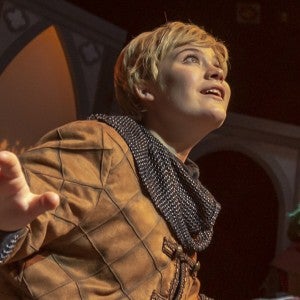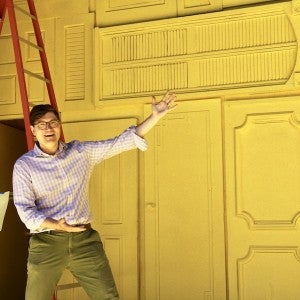World Theatre class introduces Academy students to Noh, an ancient Japanese style of performance
The class is a unique opportunity made possible by instructor Gulshirin Dubash, who studied with the Noh Training Project.
Students perform traditional Noh choreography.
Walk into the World Theatre class at Interlochen Arts Academy, and it’s like entering another hemisphere.
The class begins quietly, with Gulshirin Dubash and her students kneeling in rows on the wooden floor. At her signal, all the students burst into song—a deep-toned, powerful Japanese chant that commands attention. Soon everyone is on their feet. Dubash flicks open a fan and leads the class through slow, carefully controlled movements. They shuffle forward, turn slightly, and bow, chanting all the while.
When they’re done practicing the choreography, Dubash has an announcement to make: today, for the first time ever, the students will get to try on a traditional Noh mask.
The excitement in the room is palpable.
Masks and fans: discovering an ancient form of theatre
This spring, Dubash is introducing Interlochen Arts Academy students to Japanese Noh, one of the world’s oldest forms of theatre. Its distinctive chanting, minimal props, richly-embroidered costumes, and carved wooden masks make it instantly recognizable.
Dubash has taught the class each year for the past 11 years, and she has had an interest in Eastern theatrical forms for a long time. Born, brought up, and still living part-time in India, she finds herself at home in a variety of global theatre traditions.
“I grew up being exposed to a variety of different cultural forms, rituals, and traditions from all different groups, so I developed a deep interest in anthropology and sociology,” she says.
In the course of Dubash’s varied career, she’s worked with Clowns Without Borders, sailed on the Greenpeace ship Rainbow Warrior, and done “guerilla theatre” in the streets of India to advocate for environmental reform. She was first exposed to Noh during a theatre history class in college. Pursuing a passion shared by only a few English-speaking performers, Dubash studied with Akira Matsui, Mitsuo Kama of the Ko School, and Richard Emmert of the Kita School at the Noh Training Project and Theatre Nohgaku, the only English-language Noh theatre company in the world.
There are so many technicalities to it and as performers, we have to appreciate that. We go about it with a lot of respect, knowing that we are not professionals.
“The performers wear masks, and the sounds coming out of their mouths are very stylized,” says Dubash, explaining the essence of Noh. “So is the movement—it doesn’t look realistic at all. It’s done like that because most of the work was done and continues to be done for religious and devotional purposes.”
She is careful to emphasize to her students that they are only getting a basic introduction to the world of Noh.
“We can't say we're doing Noh,” says TJ McCarthy, a junior at Interlochen Arts Academy and a student in Dubash’s class. “We mainly just have to say that we're learning about it. It would be inappropriate for us to say that we are doing it, simply because we were not trained in it. There are so many technicalities to it and as performers, we have to appreciate that. We go about it with a lot of respect, knowing that we are not professionals.”
A sacred transformation
Today, the students listen with interest as Dubash describes the making of a Noh mask. Carved from cypress wood and coated with up to forty layers of paint and lacquer, this mask’s soft features are meant to represent the face of a young woman.
A student volunteers to try it on, and Dubash asks her to turn her back to the class while the mask’s straps are adjusted around her head. The moment of an actor’s transformation is considered a sacred one, not to be seen by the audience.
“There's this feeling of respect and weight that goes into putting on the mask because when you get into the mask, you look at the mask first and see the character for who they are,” says McCarthy. “Once you put that mask on, you have to take on and breathe in all the responsibilities to tell the stories that we’re putting on.”
No one claps at the end, because the performance isn’t done for the sake of entertainment: the performance is a gift, a sacred act in honor of something bigger and higher than us. In that case, what are you clapping for?
In another major departure from Western theatre, the plots of Noh productions aren’t meant to be a surprise to those watching. Most Japanese audiences are already familiar with the mythological storylines, so the point of the performance is “the artistry of the performer within that form,” says Dubash. And when a Noh performance is over, the audience doesn’t applaud.
Dubash explains: “No one claps at the end, because the performance isn’t done for the sake of entertainment: the performance is a gift, a sacred act in honor of something bigger and higher than us. In that case, what are you clapping for?”
McCarthy expresses appreciation for the unique opportunity the class afforded him.
“A lot of theatre that we do in the West takes stories from all around the world and puts them on stage,” says McCarthy. “Being able to know a little bit about how other people do theatre is just so important. I think the highlight of the whole class is broadening our view as artists.”
Learn more about Theatre at Interlochen Arts Academy.




